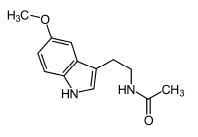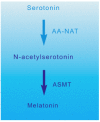Melatonin: Pharmacology, Functions and Therapeutic Benefits
- PMID: 28503116
- PMCID: PMC5405617
- DOI: 10.2174/1570159X14666161228122115
Melatonin: Pharmacology, Functions and Therapeutic Benefits
Abstract
Background: Melatonin synchronizes central but also peripheral oscillators (fetal adrenal gland, pancreas, liver, kidney, heart, lung, fat, gut, etc.), allowing temporal organization of biological functions through circadian rhythms (24-hour cycles) in relation to periodic environmental changes and therefore adaptation of the individual to his/her internal and external environment. Measures of melatonin are considered the best peripheral indices of human circadian timing based on an internal 24-hour clock.
Methods: First, the pharmacology of melatonin (biosynthesis and circadian rhythms, pharmacokinetics and mechanisms of action) is described, allowing a better understanding of the short and long term effects of melatonin following its immediate or prolonged release. Then, research related to the physiological effects of melatonin is reviewed.
Results: The physiological effects of melatonin are various and include detoxification of free radicals and antioxidant actions, bone formation and protection, reproduction, and cardiovascular, immune or body mass regulation. Also, protective and therapeutic effects of melatonin are reported, especially with regard to brain or gastrointestinal protection, psychiatric disorders, cardiovascular diseases and oncostatic effects.
Conclusion: This review highlights the high number and diversity of major melatonin effects and opens important perspectives for measuring melatonin as a biomarker (biomarker of early identification of certain disorders and also biomarker of their follow-up) and using melatonin with clinical preventive and therapeutic applications in newborns, children and adults based on its physiological regulatory effects.
Keywords: Adaptation to external and internal environment; biological clocks; biomarker; central and peripheral oscillators; clinical application; melatonin; prevention and treatment; sleep-wake rhythm; synchronizer.
Figures



References
-
- Lerner A.B., Case J.D., Takahashi Y., Lee T.H., Mori W. Isolation of melatonin, the pineal gland factor that lightens melanocytes. 1958.
-
- Bubenik G.A. Gastrointestinal melatonin: localization, function, and clinical relevance. Dig. Dis. Sci. 2002;47:2336–2348. - PubMed
-
- Carrillo-Vico A., Calvo J.R., Abreu P., Lardone P.J., Garcia-Maurino S., Reiter R.J., Guerrero J.M. Evidence of melatonin synthesis by human lymphocytes and its physiological significance: possible role as intracrine, autocrine, and/or paracrine substance. FASEB J. 2004;18:537–539. - PubMed
-
- Champier J., Claustrat B., Besancon R., Eymin C., Killer C., Jouvet A., Chamba G., Fevre-Montange M. Evidence for tryptophan hydroxylase and hydroxyindol-O-methyl-transferase mRNAs in human blood platelets. Life Sci. 1997;60:2191–2197. - PubMed
-
- Conti A., Conconi S., Hertens E., Skwarlo-Sonta K., Markowska M., Maestroni J.M. Evidence for melatonin synthesis in mouse and human bone marrow cells. J. Pineal Res. 2000;28:193–202. - PubMed
Publication types
MeSH terms
Substances
LinkOut - more resources
Full Text Sources
Other Literature Sources
Medical
